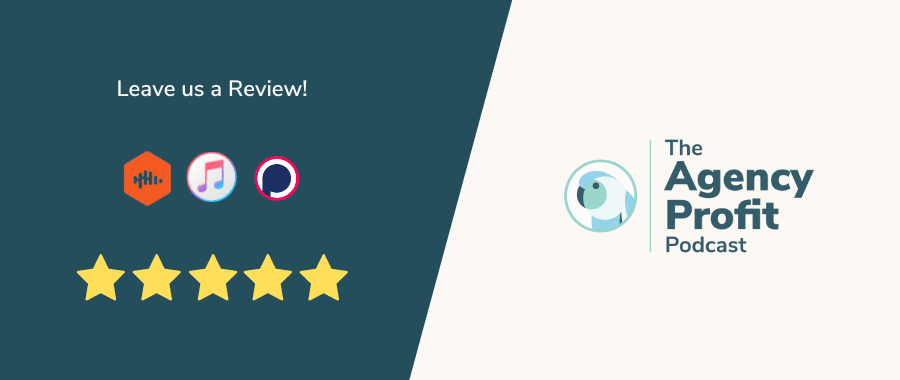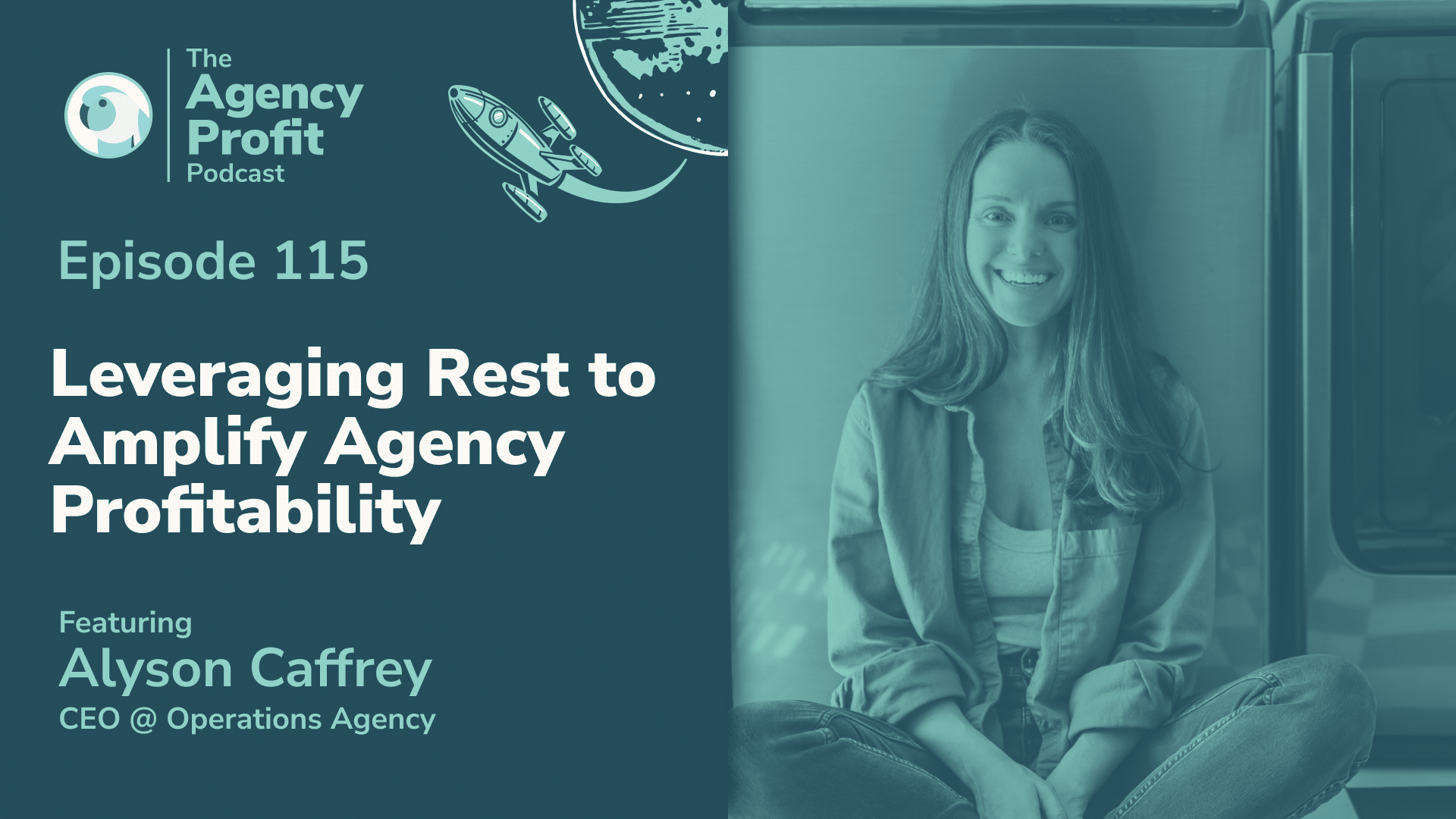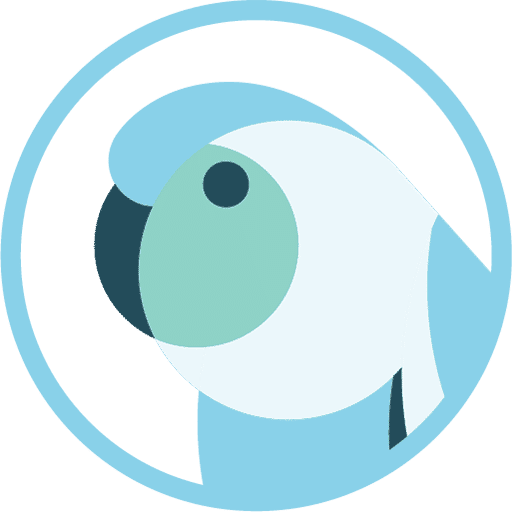We have the pleasure of being joined by Alyson Caffrey to discuss how leveraging rest and recruiting staff is key to profitability. After all, every high-performance plan – whether you’re climbing Everest or training for a marathon – includes rest. So, why don’t business owners include rest in their business growth plans?
About Alyson Caffrey
Alyson Caffrey is an operations strategist and the founder of Operations Agency. She is probably most known for her frameworks teaching operations to grow and scale digital agencies. Over the last six years, she’s been involved behind the scenes at some high-growth agencies and worked with some of the top companies in the thought leadership space.
Author of the recently released book, The Sabbatical Method: How to Leverage Rest & Grow Your Business, Alyson focuses on helping her clients build scalability AND sustainability through ops.
A mom to two little boys under three, she enjoys discussing growing businesses and families! Alyson’s family loves to be outside and their 3-year goal is to purchase land to create a farm together. She wants “all the animals and the dirt!”
Points of Interest…
- How Alyson’s Operations Agency helps Parakeeto 2:33
- What led Alyson to write The Sabbatical Method 5:15
- Core Thesis of The Sabbatical Method 8:48
- Successfully implementing the method 11:30
- Prepping for your first sabbatical 16:08
- Mitigating the inevitable relapse 21:35
How Alyson’s Operations Agency helps Parakeeto
Buckle up, because myself and Alyson (having been firm cohorts in this space for quite some time) are about to go full nerd on all things operations.
Alyson has been immersed in the field for almost ten years, the last five of which she’s been running the Operations Agency. As for what that entails? All the cool stuff, like scaling businesses, launching new products and services, implanting new team members at leadership levels, and really just making things behind the scenes work. Because, let’s face it, no one hands you a tailored manual when you, over time, find yourself running a business.
So, before we dive into some personal anecdotes for this episode, I’m compelled to be fully transparent here; we at Parakeeto have been a client of Alyson’s for some time. In particular, she and her very talented team have helped us with process documentation, specifically through the wonder of Loom.
For example; anyone on my team, at any moment (including myself), can record a Loom doing a task. Then, we send it to Operations Agency. Before you know it out comes a beautiful SOP document with screenshots and detailed explanations. It’s well formatted and it just appears – like magic – in our company playbook, which is neatly organized in Google Drive.
The point of this? Well, it enables smooth operations while, let’s say, a key member of your team needs to take two weeks off. Instead of endless meetings/emails to outline what needs to be done, all these meticulously detailed yet easily followed SOP docs are there for everyone to reference in this team member’s absence.
What led Alyson to write The Sabbatical Method
Alyson’s methods have proved so invaluable to the ethos of operations that she’s done the agency space a huge service, by releasing her book. Her motivation? Initially, motherhood and all the balancing acts it brings. It came from growing her business and taking two maternity leaves over the last three years.
“When I had my first son, there’s this lovely picture of me; I’d just gone through birth, I had my son in my arms, and the very next moment – which isn’t documented – I was on my email, checking in with clients, sending voice texts to team members… I was like, ‘Oh man, I’m starting this off day one. My son is not 24 hours old yet, and already the priority in my life is very clearly my business’.”
Instead of drawing a hard line in the sand, Alyson took a balanced approach as an owner, seeing it as a crossroads and an opportunity for personal growth.
“John Maxwell talks about the leadership lid and all of our personal development as it relates to how we show up and we grow our business. That said, we need to start thinking about the ultimate question that I ask in the book – can your business function without you? More importantly, can it thrive without you?”
Unfortunately, a lot of business owners are forced to answer this question when they’re “voluntold” to take time off from the business. They’ve either neglected their personal health, or a team member ends up leaving, resulting in this enforced reckoning of, “Wow, I actually can’t go anywhere without being pulled back into my business.”
If you’re thinking, “Well, that’s just part of being a business owner”, let me assure you that doesn’t have to be the case. Let’s engage in some necessary “what-ifery” for a moment. What if you want to give your hardworking team members access to actual vacations? What if you want to usher in a new team member, or send another team member onto their next opportunity? You need to be able to access a system to enable these events – which will happen whether you want them to or not.
“I personally did this in my own life. You know, my second maternity leave was leaps and bounds better than the first. And I thought, why not share this? Bring it to the folks who need it most, especially as we’re running businesses, growing families, and leading teams.”
You don’t necessarily need to be growing a family to bring Alyson’s methodology in your life. If you find yourself, like me at one point, with no food in your fridge, in serious need of a shower, and far fewer friends than you used to have (not just due to the sparse showering, but rather “not having time” to connect) then you’re a prime candidate.
Core Thesis of The Sabbatical Method
It’s time to get tactical! What exactly is The Sabbatical Method? What is the secret sauce here behind that, that key idea?
“Basically, it’s a way to approach removing yourself from the day-to-day operations and spotting some of those inefficiencies operationally that can support you at the next level.”
So, this involves literally extracting yourself from – as Alyson puts it – the “doing actions” into more of an “assisting action” role. If you feel like you can’t access even two weeks off, you need to be intentional about the ways in which you can remove yourself from a lot of the “doing”. This way, you can then address these inefficiencies operationally and lay a really solid foundation for the next phase. As for what that next phase might be? Well, it involves defining what you want your role to ultimately be within the business.
“A lot of us are responsive to what we have to be inside of our business, right? We start the business and we’re the lead salesperson. Then, we grow our business and we’re the lead marketer. Then we keep growing our business and we’re the lead fulfillment expert in all the things. We end up wearing all of the hats and it starts to get a lot.”
This is when things start to get really reactive. You need to start asking what you want from your role within the business. Beyond that, you also need to ask yourself what you want your role in life and in your family to be. How much time do you want to dedicate to being intentional about your relationships alongside your business?
“Think of it as giving yourself a promotion first. Then we can start to move into taking longer-term periods of time off from the business.”
Successfully implementing the method
Personally, I love this idea of protecting your time and how that subsequently becomes the forcing function – as opposed to waiting for the day when you’re inevitably hospitalized and you have to figure out delegation on the fly. So, what is the key to successfully implementing the Sabbatical Method? Because I’m sure it’s very easy to slip up and totally not allow yourself to get the full benefit.
“Be intentional about doing it right and really commit. If this is what I’m gonna commit to for X amount of time, then show up, do the work, and make sure that you’re creating some of the boundaries that you need to actually remove yourself from the business.”
So, if you decide to take – as Alyson mentions in the book – more of the “assister role”, you can start carving out a two-week stint away from the business by reframing how you interact with your team. Then we need to show up that way in your meetings, and in your day-to-day work. This new version of you as a leader needs to become your identity.
If your first step to moving towards a sabbatical is intentional and sees you commit to what you see you’re ultimate role being, then the second step is defining what a sabbatical is for you.
“I think a lot of folks approach a sabbatical and they think one of two things on opposite ends of spectrum. They either think that this is something accessible only to C-Suite or founders of Fortune 50 companies who get to take six months off and go work on projects and do whatever. Or it’s a forcing function for a health or mental breakdown of some kind.”
However, there is this space in the middle that people need to start accessing, as the outcomes are super beneficial. It is, as Alyson points out, akin to training for a marathon or the CrossFit games *more on this from 15:04 minutes*
Prepping for your first sabbatical
So, let’s assume you’ve committed to re-positioning your role in order to think about the business, and managed to block out the time for that. How can you prepare yourself – and your team – for the long list of stuff that otherwise wouldn’t get done? Moreover, how can you do this without scarring you/your team for life?!
“Go into it with a shed of positivity and be willing to release the quest for perfectionism… the ultimate way to create a sellable, scaleable asset is to remove yourself from it. That also means removing your perfectionism.”
In other words, you don’t need your mitts all over everything in order for it to be done well. Instead, imbue your team with the confidence that they can handle any potential fires in your absence. And here’s how it’s done…
- Clear communication: Ask ALL the questions, like what is going on? How long is this going to take? What is the client’s expectation?
- Assign your Commissioner Gorden: If you’re not a Batman fan, essentially you need to make one person your lone point of contact, and ensure they’re aware of the parameters by which they make contact on the Bat Phone. That defined criteria will, of course, be unique to your agency.
- Start recording your screen: This is the quickest way of documenting your tasks. Loom is free for a short period of time, plus your videos shouldn’t be longer than five to seven minutes anyway for a key concept.
- Standardize before you optimize. Be OK with standardizing first: You’re not going to reach perfection the first time. We forget that our process isn’t optimized yet, but it is there and someone can take it, right? Everything is a process.
***We have further insight on this from 18:55 minutes***
Interested in the math side of it all, to figure out what your team can handle without you in the mix? The Agency Profit Toolkit is a free resource that allows you to model your agency based on any staffing changes you’re anticipating.

Get your copy for free below!
Mitigating the inevitable relapse…
We’ve talked about how to set up the sabbatical. We’ve also discussed how to prep for the sabbatical and approach it successfully. But there’s something else that needs addressing… which is the relapse. We’ve all done it, right?
We get out of the weeds and then, for whatever reason, we’re pulled back in. For example, a lot of times, I merrily scampered back toward the undergrowth due to an identity crisis. I didn’t know what to do with myself because I wasn’t busy anymore. I was being forced to address existential questions in my life that this time and space was exposing me to. If this sounds familiar, trust me, you’re not alone!
In such instances, how can we navigate these scenarios – when we come back from the sabbatical and we’ve actually used it to successfully get a bunch of things delegated to the team and systems created?
“Again, intention. Making sure that you can answer that one key question, or one key goal. It’s gonna be a guiding post for a lot of folks who are planning this.”
In addition to taking care of yourself physically, first and foremost, Alyson suggests focussing on the inefficiencies in one area of your business – if your only job is not to touch the business. Once you’ve defined that one thing, learn about it, get books and listen to podcasts on the matter. Accept the information that is there.
Then, as you rest, you have the brain space to digest that information before applying it to your own situation once you get back into the business ***More insight on the merits of being open to learning and the difference between that and procrastination from 24:32***
Key takeaway…
Getting out of the weeds of your business can actually help you find elegant solutions to your problems. As Alyson deftly puts it; the term “my business is my baby” needs to evolve to “my business is my capable adolescent or thriving adult.” Loosening the grip on your business may actually allow it to thrive independently of us. That’s a good thing!
Her keys to achieving this include…
- Committing to being intentional about the future of your business
- Taking an honest look at the way your business is operating
- Seeing how you can extract yourself from the day-to-day so you can make higher-level decisions on how you operate long-term. Once you get above the business you can leverage this new perspective.
- Embrace the imperfections, it’s a sign of progress!
“If revisions are a big core function of how you actually operate, stop trying to optimize your client journey for no revisions; no one ever hits it out of the park and never has to come back with a client revision? Get used to being okay with those maintenance procedures, right? We don’t cut our lawn once and then never cut it again. We gotta build that in.”
In short, there were so many areas of the business where I felt like I had to hang on to things until it was solid enough to turn into a process. But, really, all I had to do was write down the principles and I could trust my team to take care of the rest.
See more from Alyson…
- Operations Agency
- Operations Agency LinkedIn @operationsagency
- Operations Agency YouTube @operationsagency
- Alyson’s Instagram
Did you learn anything new from this episode? Let us know in the comments below! We have helpful blogs designed to bolster your agency profitability, such as How To Calculate Your Billable Employee Cost-Per-Hour.
Our next installment of #APP, on June 28th, will see Marcel talk with Paul Bellows for our 116th edition. Our previous blog – Episode 115 with Ashley Carroll – can be viewed here…
Avid #APP Listener?!
We would be eternally grateful if you could leave us a review…

Agency Profitability Tool Kit
If you’re looking for more resources to help you improve your agency’s profitability, check out the Agency Profitability Tool Kit. It’s full of templates and checklists used when consulting clients. This helps them improve profitability by over 100% in under 60 days.
Fill out the form below for your copy!






0 Comments